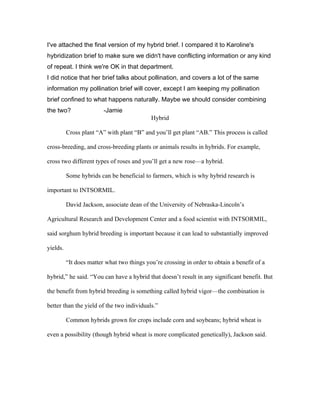
Brauer Purdue Research
- 1. I've attached the final version of my hybrid brief. I compared it to Karoline's hybridization brief to make sure we didn't have conflicting information or any kind of repeat. I think we're OK in that department. I did notice that her brief talks about pollination, and covers a lot of the same information my pollination brief will cover, except I am keeping my pollination brief confined to what happens naturally. Maybe we should consider combining the two? -Jamie Hybrid Cross plant “A” with plant “B” and you’ll get plant “AB.” This process is called cross-breeding, and cross-breeding plants or animals results in hybrids. For example, cross two different types of roses and you’ll get a new rose—a hybrid. Some hybrids can be beneficial to farmers, which is why hybrid research is important to INTSORMIL. David Jackson, associate dean of the University of Nebraska-Lincoln’s Agricultural Research and Development Center and a food scientist with INTSORMIL, said sorghum hybrid breeding is important because it can lead to substantially improved yields. “It does matter what two things you’re crossing in order to obtain a benefit of a hybrid,” he said. “You can have a hybrid that doesn’t result in any significant benefit. But the benefit from hybrid breeding is something called hybrid vigor—the combination is better than the yield of the two individuals.” Common hybrids grown for crops include corn and soybeans; hybrid wheat is even a possibility (though hybrid wheat is more complicated genetically), Jackson said.
- 2. According to livinghistoryfarm.org, Gregor Mendel helped sprout the concept of hybrids by crossbreeding pea plants in the 1860s. He discovered that by crossbreeding specific plants he could predict traits that the offspring would have.